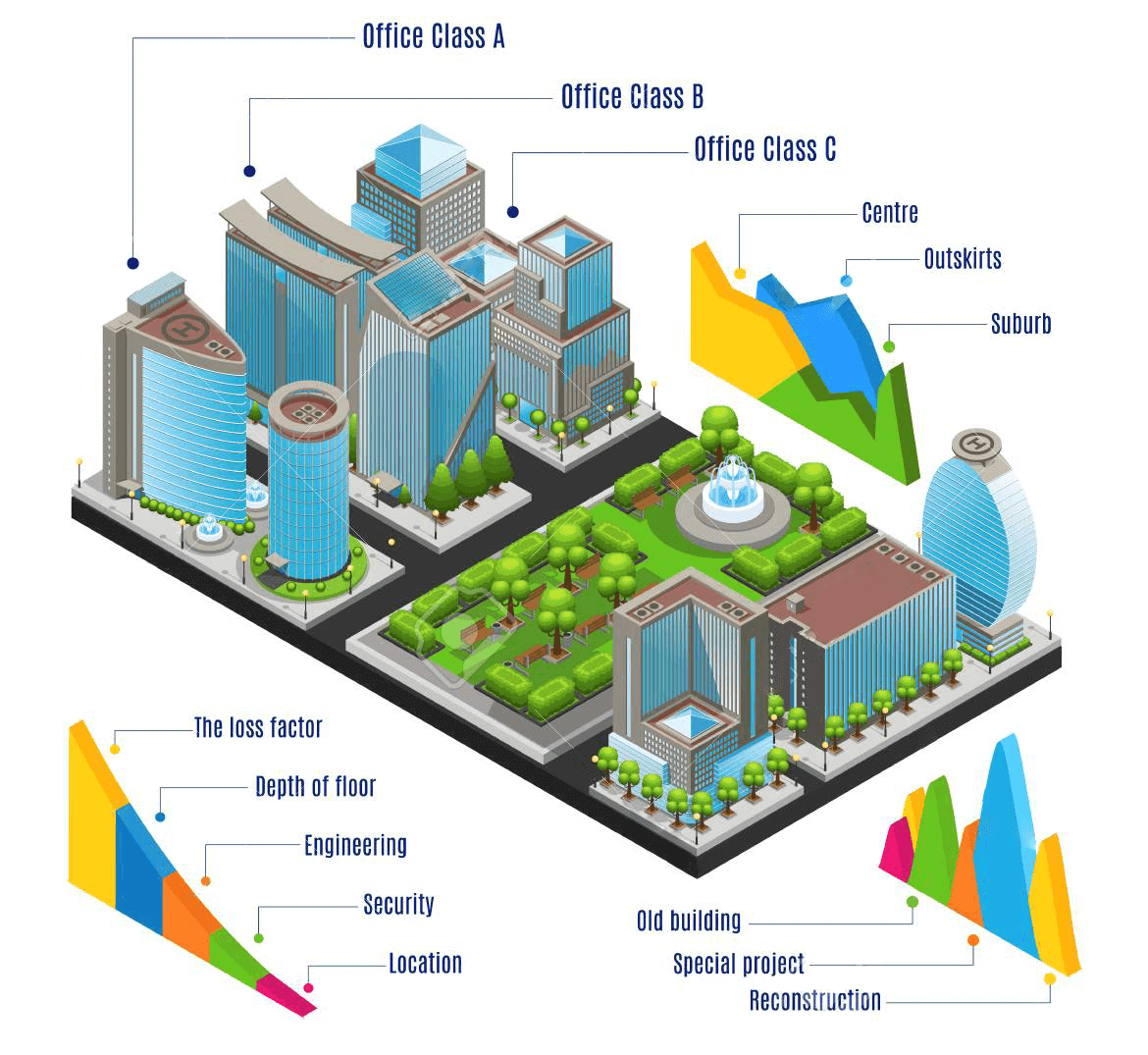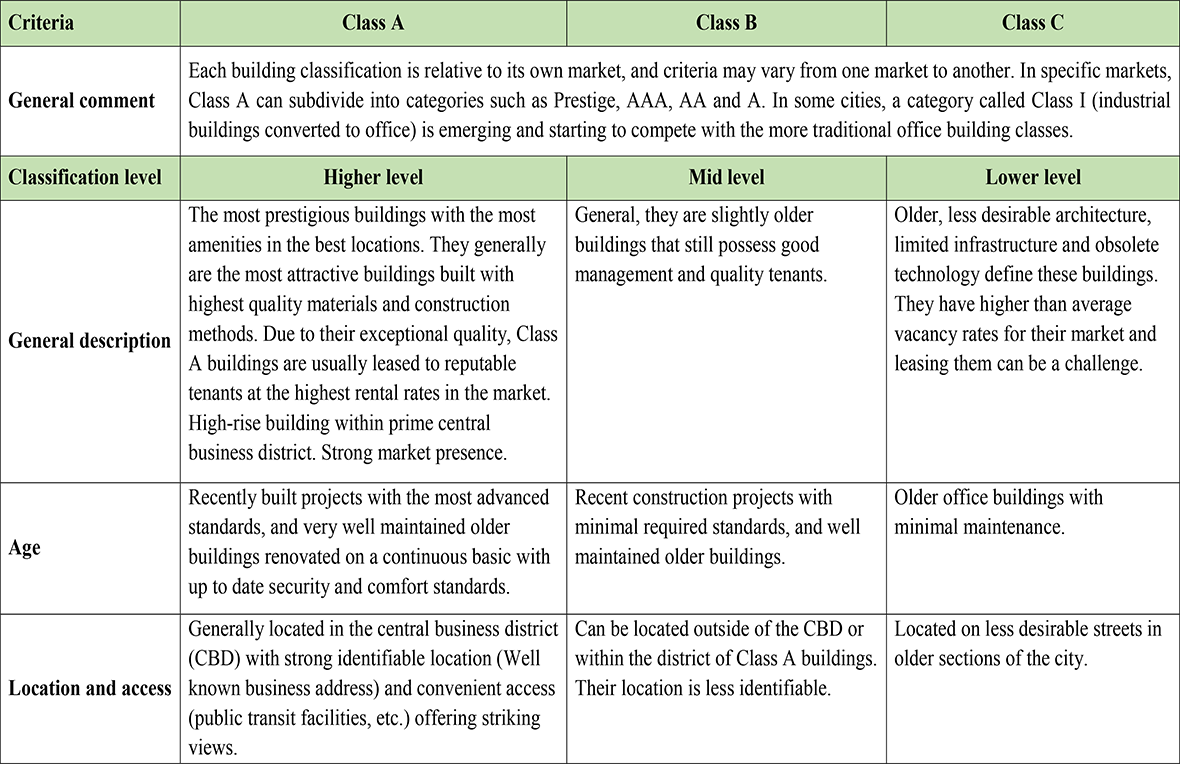Office building classification guides with criteria for each class

1. INTRODUCTION
Building class definitions categorize office buildings as Class A, Class B and Class C. In many markets, Class A can be subdivided into sub-categories such as Prestige, AAA, AA and A. New categories have even started to emerge, such as Class I (Industrial converted to office). Commercial real estate agents, owners and managers determine the class of each building. The groups consider several factors when determining the different classes.
The evaluation criteria used to determine a building’s classification allow the various actors in the commercial office building sector to share a common language and to identify market conditions per category, in an organized and readily comparable manner.
Keep in mind that class definition is not a science, as there are no formal or international standards established. However, the ratings refer to building specifics. The inventory of office space in a metropolitan market makes a distinction between Class A, B, and C buildings.
Class B and Class C definitions are based on Class A definitions. A building’s classification is relative to other properties in a given market. Thus, a Class A building in a small town will not share the same characteristics as a Class A building in the heart of Manhattan.
2. A GUIDE FOR CLASS A, B OR C OFFICE BUILDINGS
Class A Buildings
The most prestigious buildings with the most amenities in the best locations. They generally are the most attractive buildings built with the highest quality materials and construction methods. Additionally, these buildings usually have a professional manager, good access, and are typically located in highly visible areas on high traffic streets. Due to their exceptional quality, Class A Buildings are usually leased to reputable tenants at the highest rental rates in the market.
Criteria:
- High-rise building in prime central business district.
- A flagship building in its market.
- Architecture – Concrete and steel construction, distinctive design, attractive look, superior interior quality finishes in main lobby and common areas, including elevators and washrooms. Fairly recent construction or very well maintained and/ or recently renovated building. Well designed and good-size layout to accommodate one or several tenants on the same floor.
- Strong identifiable location (well known address) – Convenient access (public transportation, etc.).
- Managed by a professional firm.
- Premier tenants.
- Highest rental rates.
- Strong market presence.
- State-of-the-art systems that meet industry standards – automated mechanical, electrical and safety and security system.
- Elevator – Sufficient number of elevators for the number of floors and building population.
- Environmental – Certification. Responsible sustainability practices in place.
- Security 24/7 – controlled access system, camera monitored. For smaller buildings or those located in a outlying areas, access control system in place as well as alarm with off-site monitoring.
- Parking – Sufficient private and public parking to accommodate tenants and visitors. 24/7 access for building tenants with security controls in place. Bike stands and electric vehicle charging stations have become the norm.
- Tenant services – Experienced and professional manager providing centralized tenant service call system, including maximum response time, concierge services, tenant activities such as barbecues and holiday breakfast, new tenant welcome committee, etc.
- Amenities – Enclosed weather protected walkway connection, conference center, fitness center, service oriented retail such as convenience store, cafeteria/food court type restaurants, dry cleaning services, ATM and Wi-Fi. For stand-alone buildings not located downtown, cafeteria/food court, restaurants and coffee shops provide above-average services to tenants.
Class B Buildings
These buildings are a grade below Class A. Generally, they are slightly older buildings with good management and quality tenants. It is not uncommon for value-added investors to target these buildings with the intention of renovating them back into Class A buildings. Class B buildings are well maintained overall and quite functional. Class B office buildings commonly have an acceptable curtain wall finish, adequate (but not state of the art) mechanical, electrical and safety and security systems, and a mid-quality level of interior finish. Class B buildings complete for a wide range of users at average rental rates for their market area.
Criteria:
- A grade below Class A.
- Slightly older buildings – Good management, quality tenants.
- Buildings finishes – Fair to good.
- Good quality systems – Not at Class A level.
- Can be targeted by investor planning renovations to restore them to Class A.
- Well maintained – Functional.
- Average rental rates.
Class C Buildings
This is the lowest grade for useable office buildings. These office buildings are generally older and may be located on less desirable streets in older sections of the city, for example. Many of these buildings usually have higher than average vacancy rates for their market. Older, less desirable architecture, limited infrastructure and antiquated technology define these buildings. For these reasons, Class C buildings offer lower rental rates and can be more difficult to lease. Many times these buildings are targeted for re-development. The curtain walls and the mechanical, electrical and safety and security systems of Class C building are generally dated, and the quality of finish is often tenants who sign short-term leases for functional space at below average rental rates.
Criteria:
- Lowest grade for useable office buildings.
- Older office buildings.
- Located on less desirable streets in older sections of the city.
- Higher than average vacancy rates for their market.
- Less impressive architecture.
- Limited infrastructure.
- In need of extensive renovations.
- Obsolete technology.
- Lower rental rates – may be difficult to lease.
- Often targeted for re-development.
- Tenants requiring functional space.
3. CONCLUSION
The above descriptions are general guidelines for building classifications, although no formal standard exists. Probably the most important point to remember is that buildings are classified relative to other buildings within their market. A typical commercial real estate specialist will first determine the Class A buildings in a market by their highly desirable locations and amenities, and then classify other buildings in the market in relation to the Class A buildings.
Additional Factor to consider
- Floor load capacity.
- Ceiling height.
- Improvements to common areas.
- Nearby services (restaurants, business clusters, dry cleaning, banks, ATM, etc.).
- Access (freeway, public transportation).
A summary grid including all above-mentioned criteria for each class can be consulted in Schedule A. This office building classification guide may be reviewed in the future as needed.
4. SCHEDULE A – SUPPORT GRID FOR OFFICE BUILDING CLASSIFICATION




